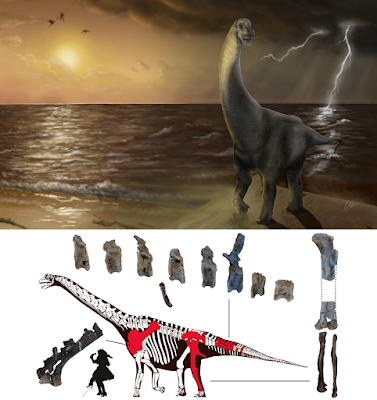[Most Recent Entries] [Calendar View]
Monday, May 20th, 2019
| Time | Event | ||||
| 3:22p | [Paleontology • 2019] Oceanotitan dantasi • A New Macronarian Sauropod from the Upper Jurassic of Portugal
ABSTRACT The Upper Jurassic of Portugal is relatively rich in sauropod remains. We describe a new sauropod specimen, which includes a partial tail, pectoral and pelvic girdle elements, and hind limb bones, from Praia de Valmitão (Praia da Amoreira-Porto Novo Formation, upper Kimmeridgian–lowermost Tithonian). This specimen constitutes the holotype of Oceanotitan dantasi, gen. et sp. nov., which shows a unique combination of characters, including the presence of anterior caudal vertebrae with a medial accessory articulation on the prezygapophysis; a circular, rough tuberosity on the medial surface of the scapula; an elliptical concavity on the ventral face of the scapula; an ischium that is shorter than the pubis; and a robust fourth trochanter located at the midline of the posterior face of the femur. Multiple phylogenetic analyses recover Oceanotitan dantasi within Titanosauriformes, with one resolving it at the base of Somphospondyli. This taxon shares several apomorphies with some Cretaceous somphospondylans and turiasaurs, such as the transverse furrow on the chevron articulations (shared with Tangvayosaurus and Phuwiangosaurus) and the ischium being shorter than the pubis (shared with Mierasaurus and somphospondylans). Oceanotitan might represent the oldest known somphospondylan, and its establishment increases the known diversity of the Late Jurassic–earliest Early Cretaceous sauropod fauna in the Iberian Peninsula, which also consists of turiasaurs, diplodocids and macronarians (non-camarasaurid, non-titanosauriform macronarians; camarasaurids; and brachiosaurids). This high diversity in sauropods suggests that this region might have played an important role during the Late Jurassic in the dispersal and diversification of several sauropod lineages between North America, Africa, and Europe, especially macronarians.
SYSTEMATIC PALEONTOLOGY DINOSAURIA Owen, 1842 SAURISCHIA Seeley, 1887 SAUROPODOMORPHA Huene, 1932 SAUROPODA Marsh, 1878 MACRONARIA Wilson and Sereno, 1998 TITANOSAURIFORMES Salgado et al., 1997 SOMPHOSPONDYLI Wilson and Sereno, 1998 OCEANOTITAN, gen. nov. Type and Only Known Species:— Oceanotitan dantasi, sp. nov. Etymology:— Oceano, from the Latin word ‘oceanus’ for ocean, which is derived from the Greek word ‘okeanós’: this specimen was found in situ at the base of the coastal cliff, in a locality overlooking the Atlantic Ocean; titan, giant in Greek mythology. OCEANOTITAN DANTASI, gen. et sp. nov. Etymology:— dantasi, in honor of the Portuguese paleontologist Pedro Dantas, who devoted his career to Portuguese vertebrate paleontology (particularly in the Lourinhã, Torres Vedras, and Pombal regions) and was one of the drivers of the renaissance of Portuguese dinosaur paleontology toward the end of the 20th century. He was also responsible for the extraction of several dinosaur specimens, including the Dinheirosaurus lourinhanensis holotype. Pedro Mocho, Rafael Royo-Torre and Francisco Ortega. 2019. A New Macronarian Sauropod from the Upper Jurassic of Portugal. Journal of Vertebrate Paleontology. DOI: 10.1080/02724634.2019.1578782 |
| << Previous Day |
2019/05/20 [Calendar] |
Next Day >> |






